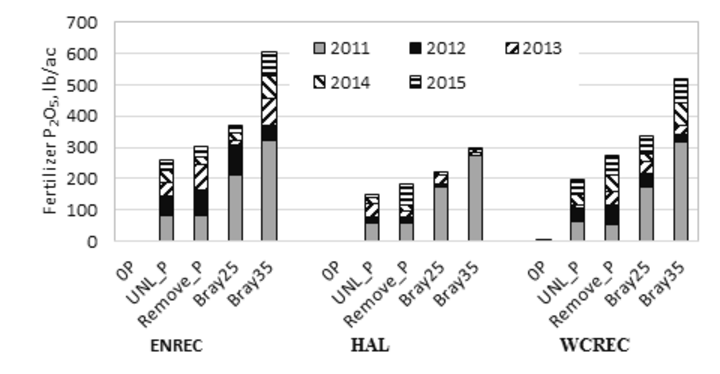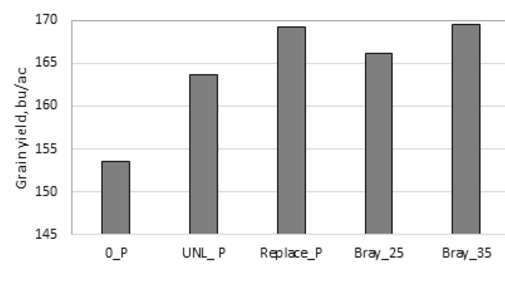Overview
Results of research conducted since 2000 to address fertilizer phosphorus (P) for corn will be reviewed. The current fertilizer P recommendations for corn will be discussed and revised recommendations presented.
Structure
Research was conducted for five years at the Eastern Nebraska Research and Extension Center (ENREC), Haskell Agricultural Laboratory (HAL) and the Western Central Research and Extension Center (WCREC). WCREC had full irrigation, ENREC had partial irrigation and HAL was rainfed. The crop was continuous corn. Bray-1 P was
- No P applied (0_P)
- P applied according to the UNL recommendation (Shapiro et al., 2009; UNL_P)
- P applied to replace P removed in harvest (Replace_P)
- Bray-1 P raised in year 1 and maintained at 25 ppm (Bray_25)
- Bray-1 P raised in year 1 and maintained at 35 ppm (Bray_35).


Results
- The amount of fertilizer P2O5 over the five years varied from 0 to 620 lb/ac.
- The P treatment effects were consistent across years and locations and only the P practice mean grain yields are reported (Figures 1-2).
- Mean yield for continuous corn was 154 bu/ac with no P applied but increased by 10 bu/ac with UNL_P.
- The mean of Replace_P, Bray_25, and Bray_35 was 4.7 bu/ac more than with UNL_P.
- There were no yield benefits to maintaining high soil test P at 25 ppm or above for all locations.
- Tillage practice did not affect response to P or yield except for 11% higher mean yield at HAL with the disk tillage treatment.
- Replace_P required more fertilizer than UNL_P, but had higher mean yield with a small profit benefit.
- Soil test P increased for all P applications with increases ranging from 8 ppm for UNL_P to 22 ppm for Bray_35.
The results of this study and three other studies will be addressed.
In short, for continuous corn:
- Tillage did not affect response to P treatment.
- Tillage increased yield by 11% at HAL but had no effect at WCREC and ENREC.
- Overall grain yield was 9.3% greater with P applied compared with no P.
- Replace_P and Bray_35 had grain yields of 169 and 170 bu/ac, respectively, which were greater than 164 bu/ac with UNL_P
- Bray_25 had intermediate grain yields
- There was no yield or economic benefit to maintaining Bray-1 P at 25 or 35 ppm
- Replace_P could result in 3% greater grain yield compared with UNL_P while applying 19% more P; profitability should be considered: Using the Corn Price (bu): P2O5 price (lb) ratio:
- UNL-P broke even at a ratio of 4.3
- Replacement_P broke even at a ratio of 3.4
- Therefore the greatest profit opportunity is to apply P to match P removed in harvest
- If Bray-1 P is larger than 20 ppm, P applied should be less than Replace_P and no P should be applied if Bray-1 P is larger than 25 ppm; this is partly concluded from 34 site-years of research during 2002-4 where the mean yield with fertilizer applied was ~235 bu/ac.
- The above results are for continuous corn only.
- The results do not confirm that Replace_P is better than UNL_P for corn in rotation.
- Other results found that the Bray-P can be considerably lower for the corn-soybean rotation than for continuous corn, presumably due to better root growth and mycorrhizal colonization with the rotation.
- Watch for a revision of Nutrient Management Suggestions for Corn, EC 117, to be available online at Extensionpubs.unl.edu.

